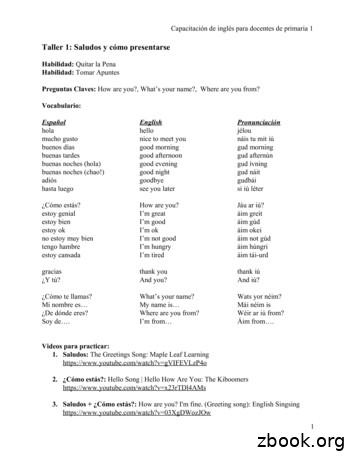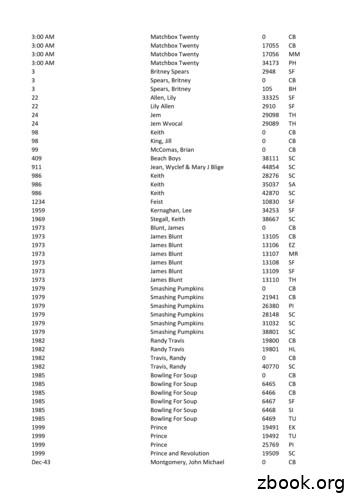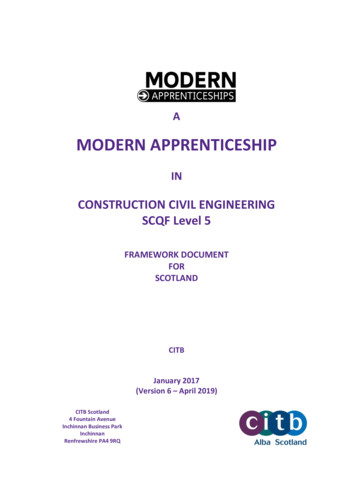OTAC: Introduction Jenn: Good Morning And Welcome To
OTAC: IntroductionJenn: Good morning and welcome to today’s webinar, “Identifying Risk with theONA Risk Report.” This webinar is intended for Service Coordinators and PersonAgents who support people in in-home settings. Today is Tuesday, October 6th2020.My name is Jennifer Buss, a program representative at OTAC and The Arc Oregon.We’re providing today’s webinar at no cost to you with funding provided throughOregon’s Office of Developmental Disability Services, or ODDS.As some of you may remember, this webinar was originally scheduled in March.At that time, the webinar had been canceled due to the emerging pandemic andshifting priorities of the field. Much of today’s webinar was recorded for thatoriginal session, so you will hear a few March dates mentioned during today’swebinar. When that happens, you’ll see a box appear on the slide, correcting thedates mentioned.As of October 1st 2020, the ONA Risk Report is now an option for ServiceCoordinators and Personal Agents who support people in in-home settings. Theguidance documents detailing how to use the ONA Risk Report were also releasedon October 1st.Today’s webinar will be presented by three of our Oregon ISP trainers, myself,Aniko Adany, and Jen Dibello. OTAC has been collaborating with and providingtraining and consultation to Oregonians since 1984. As of April 2018, OTAC nowoperates as a program of The Arc Oregon. We are also happy to be joined byEddie Plourde, a board member of the Oregon Self Advocacy Coalition, or OSAC.Today we’re also joined by several people from Oregon’s Office of DevelopmentalDisability Services, or ODDS. This includes Melissa Elliott, the Service EquityManager; Fred Jabin, the Assessment Unit Manager; and Brent Watkins, theQuality Assurance Unit Manager. It’s great to have you all with us this morning.We’ve posted a copy of today’s slideshow and a few handouts in your webinarcontrol panel. Take a moment to explore the webinar control panel and downloada copy of the materials. You may also submit questions at anytime during thewebinar. Our team will follow-up with you after the webinar with answers to yourquestions.1
To address your questions, we will also be providing a “frequently askedquestions” document. We will email this to everyone who registered for the livebroad cast of this webinar.With that, I’m going to turn this over to Fred Jabin, the ODDS Assessment UnitManager, to get things going.Introduction of ChangesFred: The purpose of today’s webinar is to discuss the Oregon Needs AssessmentRisk Report, who will be using it, when they can use it, how they can use it, andwhat it will do. The most important part is that this is an option for people whoare in in-home services, for their Services Coordinators or Personal Agents to use,so it applies to Services Coordinators and Personal Agents who support people inin-home settings and it does not apply to people who live in other types ofsettings, such as 24-hour residential, supported living, or foster care. The ServiceCoordinator or Personal Agent will choose whether they are going to use the RiskIdentification Tool (RIT) that is currently being used or if they want to switch anduse the ONA Risk Report. This webinar will tell them how to use that and how toapply that to the ISP process.I want to talk a little bit about the differences between the two tools and why wecreated those. So the Oregon Needs Assessment was created with a lot of inputfrom people all around the field. We created the Oregon Needs Assessment astwo requirements were put down to us. One was the federal government, CMS,requires that there is an annual functional needs assessment for everybody whoreceives I/DD services and the Oregon legislature told us that we needed to haveone assessment tool that captured them all. Previously, we had the CISassessment, the SNAP assessment, the ANA assessment, and the CNA assessment,and they told us that we needed to have one assessment for all people. We had astakeholder group that looked at a variety of different tools and decided in theend that we should create our own tool. As part of that project, we began askingpeople around the field, people receiving services, their families, their providers,2
and the case managers who work with them what things we needed to measureto make sure that we could capture the things that people needed support for,and risks that they encountered. And we consistently heard back the samefeedback is that we needed to consolidate some of our tools, that not only did wehave the different functional needs assessments, but that we were also askingpeople very similar questions in the Risk Identification Tool and the Level of Careand they wanted all of those things put into one tool to be used so that peopledidn’t have to have so many different meetings where people asked themsometimes invasive or personal questions. At the same time, we were hoping toreduce some of the workload for case managers who had to fill out severaldifferent tools. So the request was that instead of having a separate RiskIdentification Tool that we would identify those risks asked in the Oregon NeedsAssessment and would then be able to print those out on a separate report whichwill identify those risks. And that’s where the ONA Risk Report came from.We are still working on how to implement that with all group and that is why weare starting with this option of it being used in in-home settings. We will becollecting data afterwards on how this process worked and if there areimprovement that can be made. Because we really want this to be a tool that willwork to help identify those but not limit people based on the tool based on justthe tool itself but really be responsive to the individual’s needs and risks.And now I’m going to turn this over to Jen DiBello from OTAC and Eddie Plourdefrom the Oregon Self Advocacy Coalition.OTAC/OSAC: Self Advocate Perspective on Risk Identification and ReportingJen: Hi, my name is Jen DiBello and I work with the OTAC program at the ArcOregon.Eddie: And I’m Eddie Plourde, part of the Oregon Self Advocacy Coalition, andJen’s husband.Jen: We are going to talk about why risk identification is important, and somethings to keep in mind while talking about risks with people and their families.3
Eddie: Talking about risks is not easy but it’s important. You have to get throughthem and it’s hard to talk about these kinds of things, especially when you’refeeling down in the dumps.Everybody deals with risks every day – if something happens to me, like if mypower chair falls apart and I run it without getting it fixed, I can hurt myself onthat.It’s a part of all of our lives to deal with risks daily.Jen: Yes, risks are a part of all of our lives. It’s all part of life, keeping people safeand finding out what somebody needs to learn to be more independent.In my life, I have never lived without mom and dad, and someday I want to livewith my husband, Eddie. I feel safe around him, even though it freaks mom anddad out a little. But parents won’t live forever and it’s important to learn how tobe more independent.My dad is more protective, I’m his baby of the family – mom is more laid back. Wewill take things one step at a time. First, Eddie will get his apartment, he will livethere for a while and invite me into his environment, I’ll spend the weekend, andso on.Eddie: People have the right to take risks in their life. This is called Dignity of Risk.It’s their life and they have the right to do it on their own.We all have the right to learn from our own mistakes, and the right to take risks inlife without being labelled.It’s hard to talk about the risks – with your Services Coordinator, it feels likeinvading my space when they are asking questions about my life. I like listening tomusic and watching tv after I have those conversations, to help me feel betterabout things.Jen: A long time ago, a Voc Rehab counselor told me and my parents that I’dnever work outside of a workshop. I remember at
in-home settings and it does not apply to people who live in other types of settings, such as 24-hour residential, supported living, or foster care. The Service Coordinator or Personal Agent will choose whether they are going to us
- Robert Kiyosaki iz Bogati otac, siromašni otac Možete li vjerovati da je Robert Kiyosaki napisao 18 knjiga u serijalu ogati otac, siromašni otac koje su se prodale u (gulp!) 26 milijuna kopija?!? Tako je. I, kao što je slučaj sa svim uspješnim pričama, postoji razlog. Kiyosaki posjeduje vještinu da pogodi
Good morning, good morning Good afternoon Good evening, good evening Good night, good night Nice to meet you Nice to meet you, too. Goodbye, goodbye. See you. (repite x2) See you later! The Greetings Song (Saludos) Good morning, good morning Good afternoon Good evening, good evening Good night, go
Songs & Chants: Good Morning, Good Evening Speaking and Listening Good Morning, Good Evening The sun comes up, Good morning! The sun comes up, Good morning! The sun comes up, Good morning! Wake up! Get out of bed! The sun goes down, Good evening! The sun goes down, Good evening! The sun goes
4 Ever Veronicas, The SF 48228 4 In The Morning Gwen Stefani CB 12265 4 In The Morning Gwen Stefani EZ 12266 4 In The Morning Gwen Stefani MR 12267 4 In The Morning Gwen Stefani PH 12268 4 In The Morning Gwen Stefani SF 12269 4 In The Morning Gwen Stefani SF 12270 4 In The Morning Stefani, Gwen CB 0 4 Minutes Avant CB 0 4 Minutes Madonna .
4 Ever Veronicas, The 48228 SF 4 In The Morning Gwen Stefani 12265 CB 4 In The Morning Gwen Stefani 12266 EZ 4 In The Morning Gwen Stefani 12267 MR 4 In The Morning Gwen Stefani 12268 PH 4 In The Morning Gwen Stefani 12269 SF 4 In The Morning Gwen Stefani 12270 SF 4 In The Morning Stefani, Gwen 0 CB 4 Minutes Avant 0 CB 4 Minutes Madonna .
Morning Millionaires #2 3 - The Life S.A.V.E.R.S. Morning Millionaires #3 PART II: What Makes a Millionaire 4 - Lesson 1: The Two Doors Morning Millionaires #4 5 - Lesson 2: You, Millionaire Morning Millionaires #5 6 - Lesson 3: Your Flight Plan Morning Millionaires #6 7 - Lesson 4: Becoming Super Morning Millionaires #7 8 - Lesson 5: The .
SALUDOS Y DESPEDIDAS RESPUESTAS Good morning (Buenos dias) Good morning /morning Good afternoon (buenas tardes) Good afternoon las 6 de la tarde) Good evening Good night /night, night (buenas noches) Good night / night, night Have a nice day
The Civil Engineering Sector provides services to the infrastructure of the industry with the following ARR. Plant Operatives 60 Civil Engineers 320 Civil Engineering Operatives 50 There may not be a large demand for additional trades within the sector, although a major infrastructure project brought forward would affect ARR numbers, there will be a demand to maintain the current levels of .























